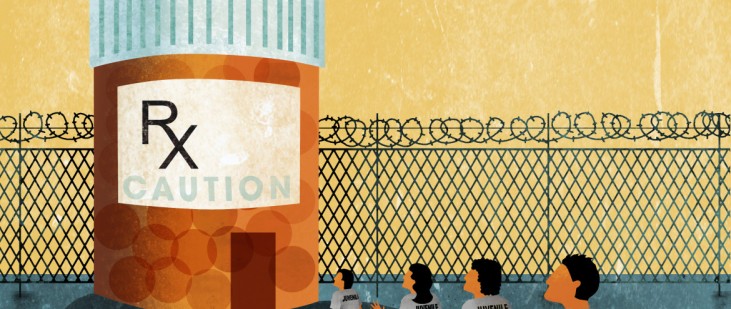By Halle Stockton | Juvenile Justice Information Exchange | October 25, 2015
It’s the end of the line for these Pennsylvania kids. They’ve fallen through every safety net, and they keep making the same mistakes or more violent ones.
The kids — nearly all black or white teenage boys — are sent hours away from their families to youth correctional facilities, sterile lock-downs surrounded by barbed wire or cabins so far out in the wilderness they’re considered secure even without a fence.
They are the toughest kids in the juvenile justice system. And, in some ways, the most vulnerable.
In the months they spend at correctional facilities, they receive mood-altering psychiatric medications at strikingly high rates, particularly antipsychotic drugs that expose them to significant health risks.
Psychiatric medications are prescribed to manage mental health and behavioral symptoms; antipsychotics are a type of psychiatric medicine approved to treat schizophrenia, bipolar disorder and irritability with autism.
Kids are more vulnerable to the severe side effects of antipsychotics — rapid weight gain and diabetes among them — yet doctors and juvenile justice experts told PublicSource they’re confident the drugs are being used off-label in the state facilities to induce sleep or to reduce anxiety or aggression.
Some child advocates refer to this use as “chemical restraint.”
Over a seven-year period, enough antipsychotics were ordered to treat one-third of the confined youth, on average, at any given time, according to a PublicSource analysis of drug purchasing information obtained from the Pennsylvania Department of Human Services, which operates the youth correctional facilities.
Only 1 to 2 percent of kids in the U.S. take antipsychotics.
Most “antipsychotic use is likely for sedation and behavioral control” in Pennsylvania’s youth correctional facilities, said Dr. Mark Olfson of the Columbia University Medical Center. Olfson is a leading research psychiatrist who reviewed the data PublicSource provided. “The new findings will hopefully spur much-needed institutional reforms.”
Thousands of at-risk kids lived in six state-operated youth development centers and forestry camps from 2007 through 2013. Within the razor wire — or dense tree lines in forestry camps — psychiatric medications are still flowing, despite the potential consequences to the developing brains and bodies of kids.
A recent study showed about one-fifth of foster care youth in Pennsylvania were taking antipsychotics in 2012 — a finding that sounded alarm bells for the Department of Human Services (DHS), which commissioned the report.
The secretary of the department called the rates among foster children “disturbing” and “unacceptable.”
PublicSource’s look at the issue for the state’s most troubled delinquent young people showed even more widespread prescribing, yet Human Services officials said they aren’t encountering the same issues in the juvenile justice system.
The agency communicated with PublicSource almost entirely through email with responses approved by its legal department.
The department had weeks, and sometimes months, to respond to questions. Requests to interview DHS officials went unanswered for six weeks; an interview with Secretary Ted Dallas was scheduled and then abruptly cancelled. PublicSource shared its findings with the agency on Oct. 6.
The state also would not release the names of the doctors who are contracted to care for and prescribe to the youth, saying that it would compromise the safety of doctors if the facility residents had personal information on them.
This story was reported and written by Halle Stockton for PublicSource.
Read the full article, originally published by Juvenile Justice Information Exchange, here.



